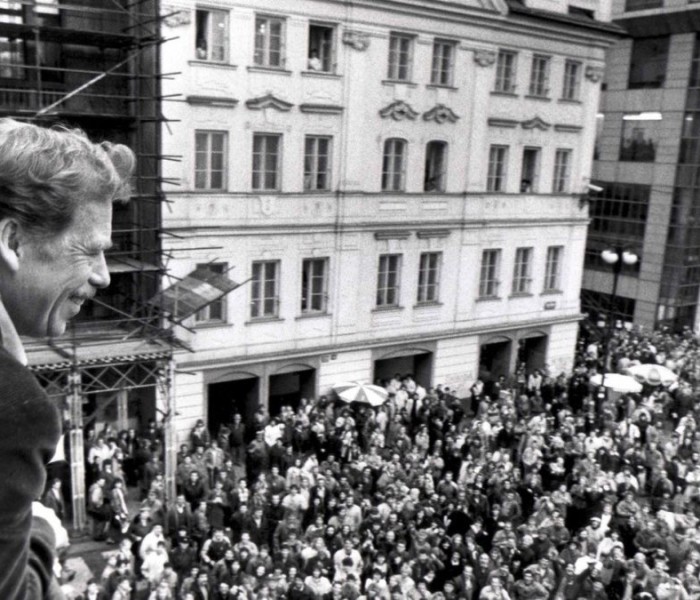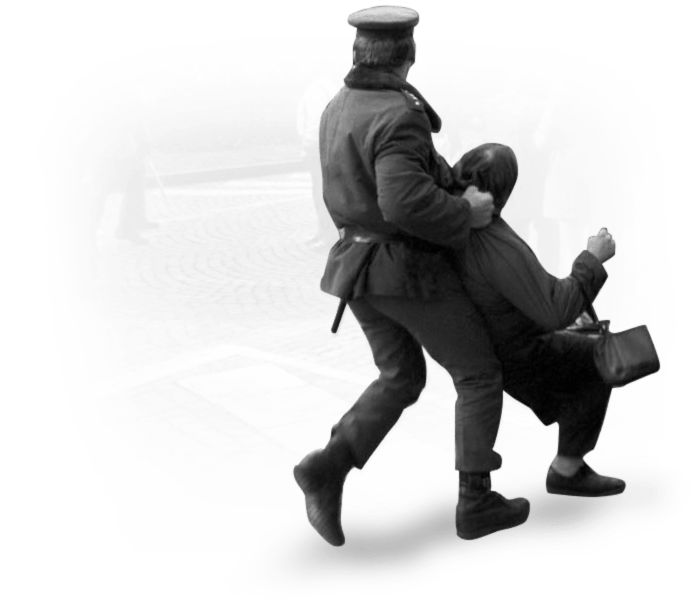
History
When Revolution Changes HistoryThe Velvet Revolution triggered significant social and political changes in the period from November 17 to December 29, 1989 that led to the fall of the communist regime and a change of the political situation in the former Czechoslovakia. Here are a few important historical events that preceeded the Velvet Revolution.
1948 - The Communist Party takes power
Jan 5 - Aug 21, 1968 - The Prague Spring
This period of mass protests against communistic regime began as public disapproval of the repressive Stalinist regime grew larger. It was a short period when society began to condemn the Communist show-trials and opened the country's borders to the West. The protests were surpressed by military invasion of the five Warsaw Convention countries (Soviet Union, Poland, Bulgaria, East Germany and Hungary) in August 1968.
Aug 21, 1968 - 1987 - Normalization
The years following the Prague Spring are known as Normalization period. Communist policies were applied, and the economic position of Czechoslovakia was quite stable. The country was therefore able to provide a certain level of wellbeing and stability for the regime. Although the standard of living fell behind that of Western European countries, economic problems did not affect the citizens too intensely and the Czechoslovakian workers were not forced to partake in protests against the regime and cooperation with intelligence. The opposition therefore remained relatively few in number, being limited mostly to the Charta 77 movement led by Václav Havel.

Very significant changes came in 1989. These were the fall of the Berlin Wall at the beginning of November, the canonization of Anežka the Czech and finally the reverence march on November, 17. Students commemorated the 50th anniversary of universities closure by the Nazi regime and intended to commemorate Jan Opletal’s memory by the march to Albertov. But instead of Vyšehrad they finally marched to Národní Třída, where they were violently stopped. The news about the brutal repression started to mobilize all social classes and led to a change of the political regime.
The swift changes were supported by the fall of the former Eastern Block and riots in Poland, Hungary, Romania and Eastern Germany.
Except for the events of November 17th, when protesters were attacked by police, the revolution itself was completely non-violent and not a single life was thwarted during the revolution. Despite the fact that the regime changed without any form of violence, society had gone through a deep social transformation.
It is not known, who used the term the Velvet revolution for the first time, but it has been used as a synonym for non-violent revolutions ever since.
Timeline
NovemberEvening of 17th November
Plans for the November Reverence March
In October 1989, the Independent Student Association STUHA organized the Reverence March on the 17th of November 1989 to commemorate the 50th anniversary of university closures by the Nazi regime. The event was to be held at Albertov in Prague. The official purpose was to commemorate Jan Opletal's memory, but more radical students intended to use this event to express their dissatisfaction...- Friday 17th November
The Beginning of the Public Manifestation
On Friday, November 17, students of Prague universities met at Albertov. The demonstration began at 16:00 with a song by Gaudeamus Igitur and a speech by Martin Klíma, a member of the Independent Student Group. This part of the demonstration ended at 16:40 and the organizers called for a march to Vyšehrad to the grave of Karel Hynek Mácha. Some people, however, intended to march to Wenceslas... - Friday 17th November
The Course of Manifestation
From the very beginning of the demonstration, anti-Communist catch-words were chanted (for example, "Masaryk on the one hundred banknote" or "Jakeš into the bin"). The Communist Party Regional Secretary Miroslav Štěpán asked the Public Police commanding officers to disperse the demonstration, but they refused, because they followed the orders of the Ministry of Interior Affairs "not to... - Friday 17th November
Termination and Dispersion of the Demonstration
Approximately at a quarter to nine, the situation changed, when it was no longer possible to leave the blockade, and the police cordon moving away from the National Theatre began to thicken the density of the crowd. The Emergency Regiment of Public Police and the Department of Special Purpose (so-called red berets) began to beat the demonstrators brutally with batons. Even after the... - Saturday 18th November
Strike Preparation
On November 18, people began to spread information about the violent interference of the police against students, which led to the activation of citizens who expressed their support for the students and disagreement with the intense interference. Following the previous event, strike committees were set up in theatres and universities to request an investigation and the punishment of those... - Sunday 19th November
Origins of the Civic Forum
In response to the protests against the brutal intervention of the police, representatives of various opposition groups lead by Václav Havel, met at the Prague Drama Club to agree on a mutual course of action. By the evening a platform was established, named the Civic Forum. The Civic Forum further announced dissatisfaction with the government, demanded the resignation of corrupt politicians... - Monday 20th November
First Mass Demonstrations
Since Monday, November, 20 most Prague universities managed to enter the Strike. Both national and federal governments of the Czechoslovak Communist Party expressed their consent to the police intervention at Národní Street and refused to negotiate with demonstrators while being forced by Strikes. The biggest demonstrations took place on Wenceslas Square in Prague, where 100,000 people met in... - Tuesday 21th November
The Entire CSSR Demonstrates
Strikes spread to most of the remaining schools (even in Slovakia) and they unitedly acted from November, 21 onward. Writer Václav Havel spoke for the first time in front of an audience from the Melantrich Publishing House's balcony on Wenceslas Square. Rattling keys became the symbol of the Velvet Revolution. Considerable line-ups of the People's Militia were moved to Prague during the... - Wednesday 22th November
Prayer for Marta
Demonstrations took place in most of the large towns on November, 22. 100,000 people came to SNP Square in Bratislava, and 200,000 people to Wenceslas Square in Prague in the evening. The Prague Demonstration ended with the first mass public performance of Marta Kubišová for 20 years, singing the song "Prayer for Marta" and the National Anthem. Large numbers of the People's Militia were moved... - Thursday 23th November
Breakpoint of the Revolution
Communist MP Miroslav Štěpán was invited to the meeting with workers in the ČKD Lokomotiva – Sokolovo Technical College. He called the protesting students "fifteen-year-olds" and therefore he was booed off the stage during his speech. Later, several thousands of ČKD workers joined the Wenceslas Square Demonstration. The act of booing Miroslav Štěpán off the stage was considered as the... - Friday 24th November
Changes in the Communist Party
Many significant political changes were made in the Communist Party that day. The Central Committee of the CP held a long meeting on November, 24, which ended after 16:00. Miloš Jakeš announced his resignation together with all leaders of the Central Committee, allowing a change of the Party’s political leadership. Gustáv Husák remained the president of Czechoslovakia. The announcement was... - Saturday 25th November
Information on Czech Television
Cardinal Tomášek served a Mass in honour of St. Anežka the Czech in Saint Vitus Temple in the morning, supported by a crowd of 10,000 faithful in the church and 50,000 in front of the church. All of them later joined the demonstration at Letná, where 750,000 to 800,000 people expressed their support to the Civic Forum. Czech Television started to broadcast the event live and announced that... - Sunday 26th November
Political Dialogue
Václav Havel as the leader of the Civic Forum Delegation met with the Federal Prime Minister Ladislav Adamec face to face for the first time in the Municipal House in Prague in the morning, for the first political dialogue mediated by the Most Initiative. The Presidium of the Communist Party resigned in the evening and handed the leadership to the so called Resurgence Stream, who clearly... - Monday 27th November
General Strike
The previously announced two-hour General Strike was held on November, 27 from 12:00 to 14:00 by 75% of citizens, the majority of the factories, companies and institutions. The slogan of the Strike was “End to the One Party Government“. 250,000 people came to Wenceslav Square, joined by another 50,000 later on. The National Anthem was sung by Karel Kryl and Karel Gott.
- November
- Plans for the November Reverence March
- The Beginning of the Public Manifestation
- The Course of Manifestation
- Termination and Dispersion of the Demonstration
- Strike Preparation
- Origins of the Civic Forum
- First Mass Demonstrations
- The Entire CSSR Demonstrates
- Prayer for Marta
- Breakpoint of the Revolution
- Changes in the Communist Party
- Information on Czech Television
- Political Dialogue
- General Strike